Force and Pressure For Class 8
Introduction
Force and Pressure are fundamental concepts in physics that help us understand how objects move and interact. Force is a push or pull that changes an object's motion, while Pressure is the force exerted on a surface per unit area. In this syllabus, we will explore the Effects of Force, Types of Forces, and how Pressure works in different environments, including Pressure in Fluids and Atmospheric Pressure.
1. Force
-
Definition: A force is a push or pull that can change the motion or shape of an object.
-
Unit of Force: The SI unit of force is the Newton (N).
-
Formula: Force = Mass × Acceleration (F = m × a)
-
Examples of Force:
-
Kicking a football (applying force with the leg).
-
Pushing a door to open or close it.
-
Lifting a book from the table.
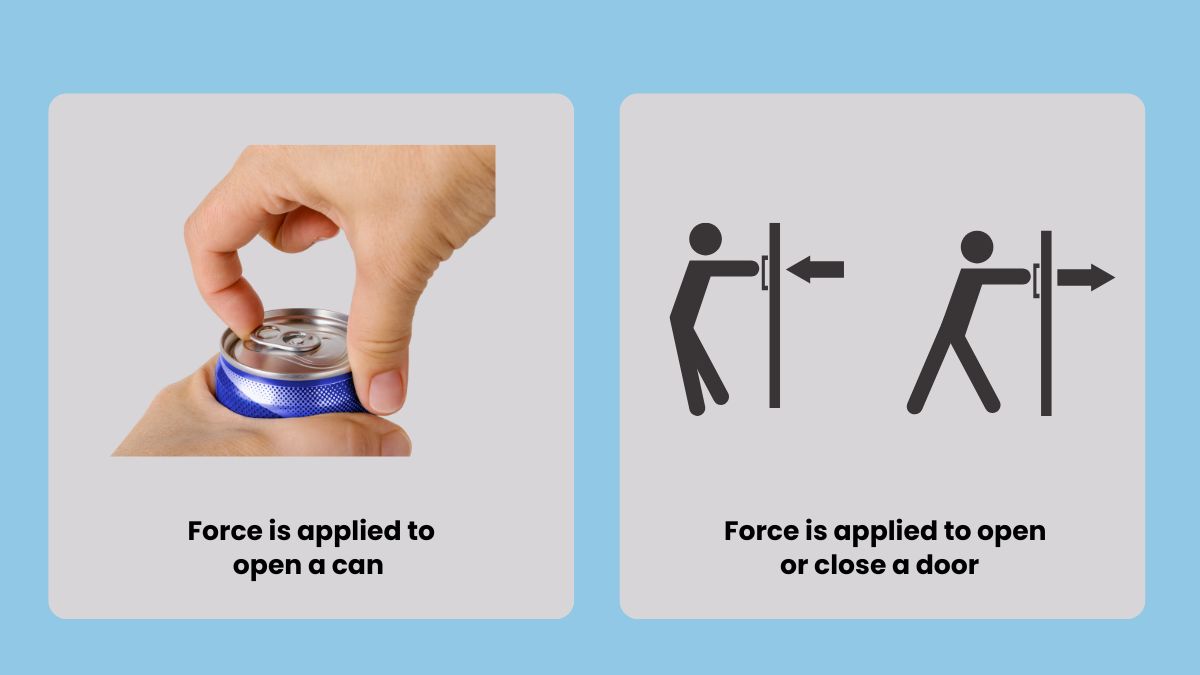
2. Effects of Force
A force can affect an object in several ways:
-
Change in Motion:
A moving body comes to rest when acted upon by a force.
For example, a moving ball caught by a fielder comes to rest. A moving toy car can be made to stop by applying force. A bicycle can be stopped by applying brakes
-
Change in Direction:
A moving body can change its direction when force is acted upon it.
For example, a batsman changes the direction of the ball bowled by a fast bowler. While playing football the players can change the direction of the moving ball by kicking it in a different direction.
-
Change in Shape:
Object change their shape or size when acted upon by a force.
For example, a rubber band when stretched changes its size and shape, we can mould a lump of clay into a variety of shapes by applying force.
-
Change in State of Rest:
A stationary object starts moving when acted upon by a force.
For example, a football start moves when you kick it. A toy car can be made to move by giving it a little push.
-
Change its speed :
A moving body can change its speed when acted upon by a force.
For example, the cycle starts moving faster when we apply more force on the pedals. Also, a bicycle can be slowed down by applying brakes.
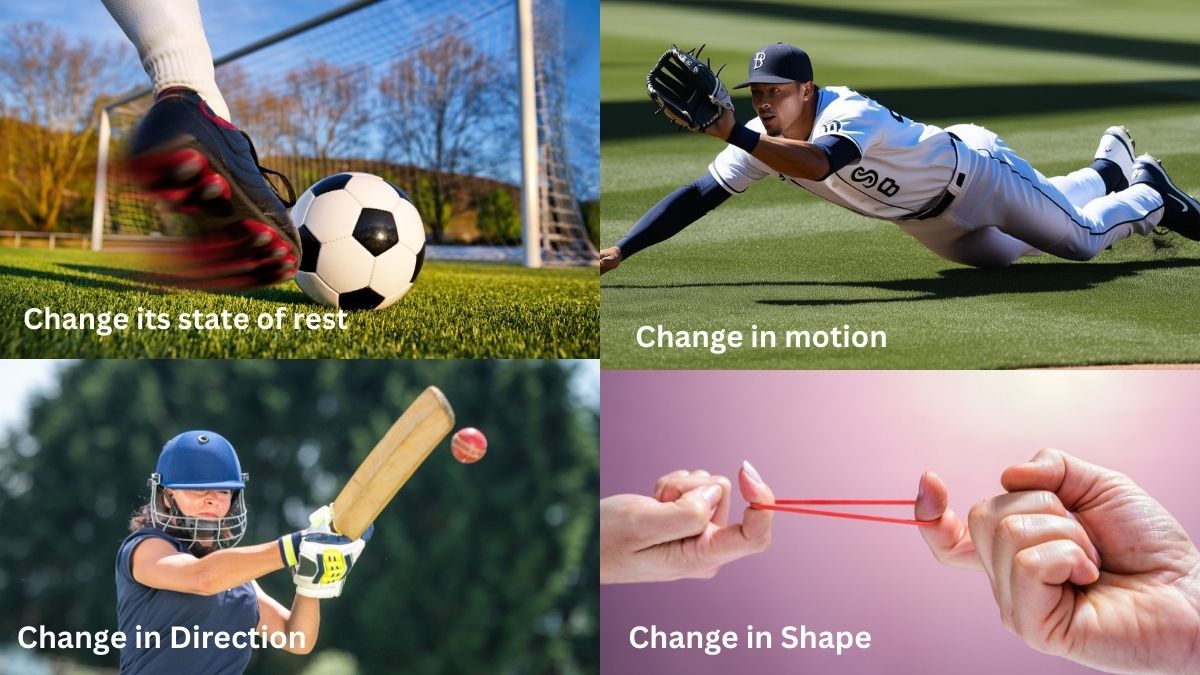
Magnitude of Force
The magnitude of a force refers to its strength or intensity acting on an object. It depends on the number of forces applied in a particular action.
-
When multiple forces act in the same direction, their magnitudes are added together, increasing the total force exerted on the object.
-
When forces act in opposite directions, the net force is determined by subtracting the smaller force from the larger force.
The effects of force vary with its magnitude. For instance, applying a small force to an inflated balloon causes slight deformation, but as the force increases, the balloon eventually bursts.
Direction of Force
-
If two individuals push a crate in the same direction, their forces combine, resulting in a stronger overall force that moves the box more easily.
-
However, if they push the box in opposite directions with equal force, the forces cancel each other out, keeping the box stationary.
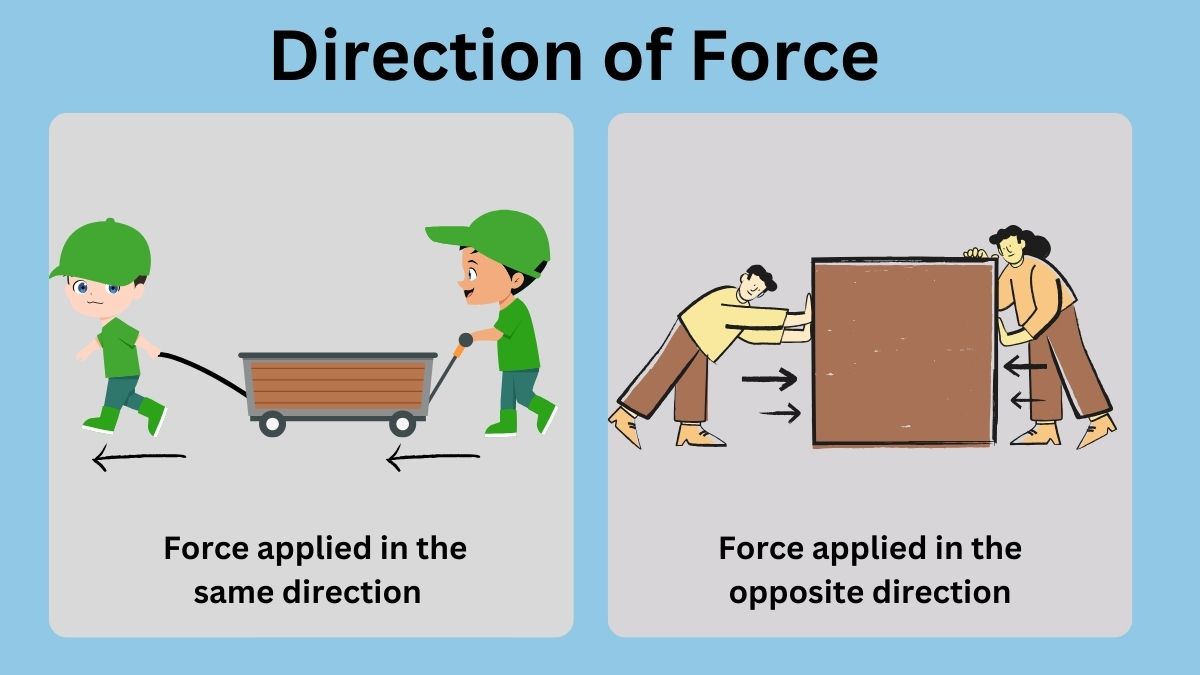
3. Types of Forces
Forces can be classified into two major types:
A. Contact Forces
These forces require physical contact between two objects.
-
Muscular Force: Applied using muscles (e.g., lifting a box).
-
Frictional Force: Opposes motion between two surfaces (e.g., a rolling ball stopping due to friction).
-
Normal Force: The perpendicular force exerted by a surface (e.g., a book resting on a table).
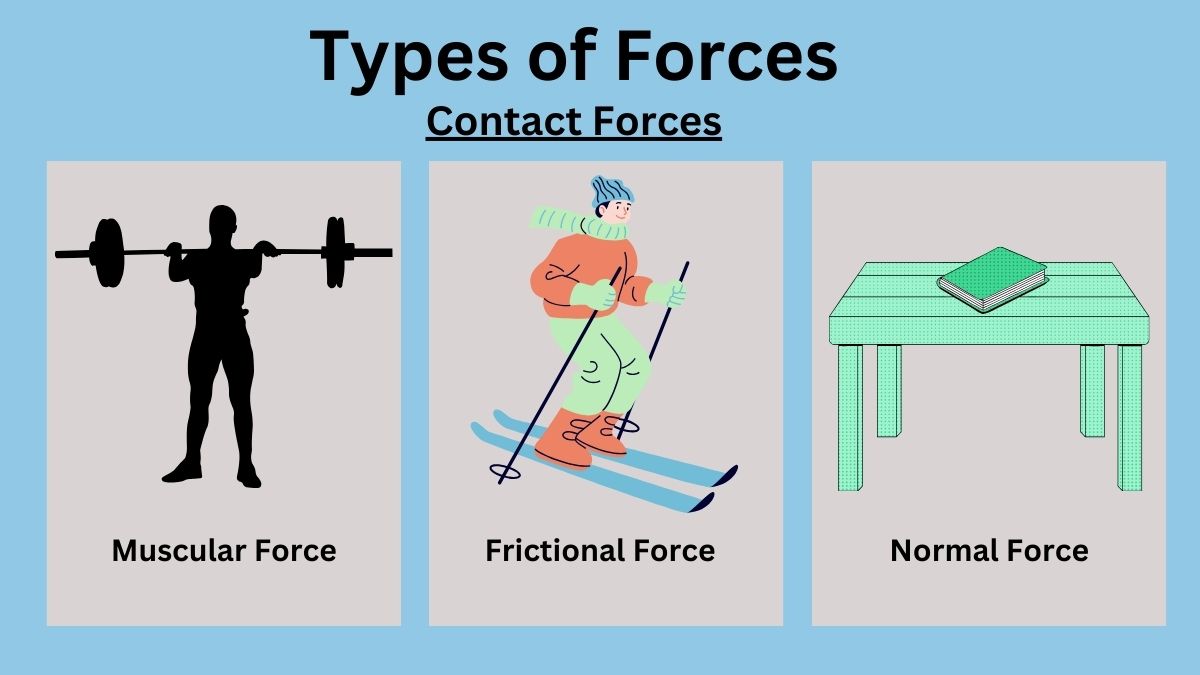
B. Non-Contact Forces
These forces act at a distance without physical contact.
-
Gravitational Force: The force of attraction between objects (e.g., Earth's gravity pulling objects downward).
-
Magnetic Force: The force exerted by magnets (e.g., a magnet attracting iron nails).
-
Electrostatic Force: The force between charged objects (e.g., rubbing a balloon on hair causing it to stick to a wall).
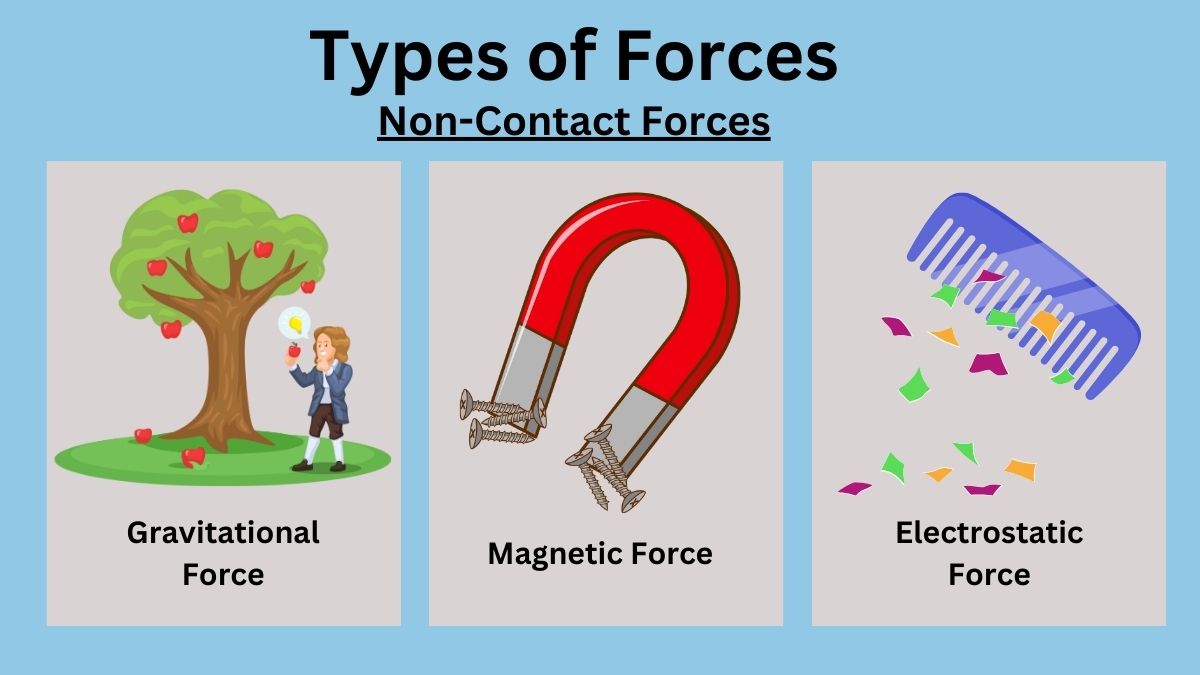
4. Pressure
-
Definition: Pressure is the force applied per unit area.
-
Formula: Pressure=ForceArea\text{Pressure} = \frac{\text{Force}}{\text{Area}}
-
SI Unit: Pascal (Pa)
-
Examples of Pressure:
-
A sharp knife cuts better than a blunt one (less area = more pressure).
-
A camel’s broad feet prevent it from sinking into the sand (more area = less pressure).
Applications of Pressure
-
Syringes – A syringe works on the principle of liquid pressure. When the plunger is pulled, the liquid is drawn in due to pressure differences.
-
Hydraulic Brakes – In vehicles, hydraulic brakes use liquid pressure to transmit force, allowing a small effort to stop large vehicles efficiently.
-
Dam Construction – Dams are built thicker at the base because water pressure increases with depth, requiring a stronger foundation to withstand the force.
-
Drinking with a Straw – When we suck air out of a straw, the pressure inside decreases, allowing the atmospheric pressure to push the liquid up into the straw.
-
Pressure Cookers – The sealed lid of a pressure cooker traps steam, increasing pressure and raising the boiling point of water, helping food cook faster.
5. Pressure in Fluids
Liquids and gases are collectively known as fluids. They exert pressure on objects submerged in them as well as on the walls of the container holding them. For example, when a wooden ball is pushed into a bucket of water, the water applies an upward force against it, resisting its immersion. This occurs due to the buoyant force exerted by the liquid.
Factors Affecting Liquid Pressure
-
Density of the Liquid – Liquids with higher density exert greater pressure.
-
Depth of the Liquid – As depth increases, liquid pressure increases.
-
Uniform Pressure at the Same Depth – At a given depth, liquid pressure remains the same in all directions.
-
Pressure in Enclosed Liquids – In a confined liquid, pressure is distributed equally in all directions.
Applications of Liquid Pressure in Daily Life
-
Dams have thicker walls at the base to withstand the increased water pressure at greater depths.
-
Deep-sea divers wear protective suits to resist the high pressure exerted by water, which is much greater than blood pressure.
Measuring Liquid Pressure
Liquid pressure is measured using a pressure gauge. The simplest type is an open-tube manometer, which measures the pressure difference between a liquid and the surrounding atmosphere. It consists of a U-shaped tube partially filled with liquid—one end is open to air, while the other is connected to the system where pressure is being measured. The difference in liquid levels indicates the applied pressure.
Pascal’s Law
French physicist Blaise Pascal formulated a principle stating that any increase in pressure applied to an enclosed liquid is transmitted equally in all directions.
Applications of Pascal’s Law
-
Hydraulic Press (Bramah Press) – A device used to compress materials, utilizing Pascal’s law for force multiplication.
-
Hydraulic Brakes – Used in vehicles, allowing a small force to be amplified to stop large vehicles efficiently.
-
Hydraulic Lift – Used in car service stations and elevators, where a small force applied to a fluid is transmitted evenly to lift heavy loads.
6. Atmospheric Pressure
Definition
Atmospheric pressure is the force exerted by the weight of air on the surface of the Earth and objects within it. The air surrounding the Earth forms a layer called the atmosphere, which consists of gases like nitrogen, oxygen, and carbon dioxide. Since air has mass, it exerts pressure in all directions, which is known as atmospheric pressure.
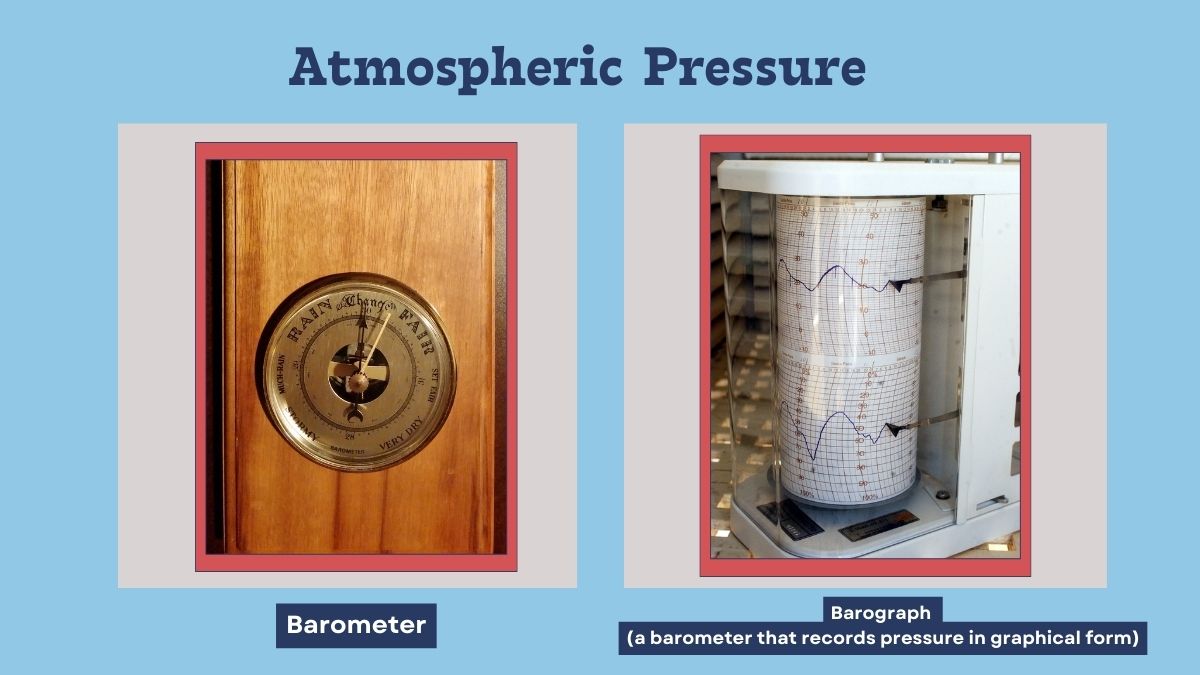
Measurement of Atmospheric Pressure
-
Atmospheric pressure is measured using a barometer.
-
The standard atmospheric pressure at sea level is 76 cm (or 760 mm) of mercury (Hg), which is equivalent to 1 atmosphere (1 atm) or 101.3 kPa (kilopascal).
Factors Affecting Atmospheric Pressure
-
Altitude – Atmospheric pressure decreases as altitude increases, since the amount of air above a given point reduces with height.
-
Temperature – As temperature increases, air expands and becomes less dense, leading to a decrease in atmospheric pressure.
-
Humidity – Moist air is lighter than dry air, so an increase in humidity reduces atmospheric pressure.
Applications and Effects of Atmospheric Pressure
-
Drinking with a Straw – When you suck water through a straw, the air pressure inside the straw decreases. The higher atmospheric pressure outside pushes the liquid up into the straw.
-
Working of a Syringe – A syringe operates on the same principle; when the plunger is pulled back, the pressure inside decreases, and the external atmospheric pressure forces the liquid inside.
-
Suction Pads – When rubber suction pads are pressed against a flat surface, air is forced out, reducing the internal pressure. The higher atmospheric pressure outside pushes the pads against the surface, making them stick.
-
Lizards’ Feet Adaptation – Lizards have natural suction-like pads on their feet, similar to rubber suction cups, allowing them to stick to walls and ceilings.
-
Leakage of Fountain Pens at High Altitudes – Atmospheric pressure decreases with altitude. As a result, the higher internal pressure inside a fountain pen pushes the ink out, causing leakage.
-
Nosebleeds at High Altitudes – The blood inside our body exerts internal pressure, balancing atmospheric pressure at ground level. At higher altitudes, atmospheric pressure decreases, while internal blood pressure remains the same, leading to the bursting of blood capillaries, which causes nosebleeds.
-
Working of a Vacuum Cleaner – A vacuum cleaner contains a fan that reduces air pressure inside. As a result, higher external atmospheric pressure forces air and dirt into the device, effectively cleaning surfaces.
Fun Facts about Force and Pressure
-
Gravity is Universal! – Every object in the universe exerts a gravitational force on every other object, no matter how far apart they are.
-
Air Has Weight! – The atmospheric pressure at sea level is about 1,013 hPa (hectopascals), which means every square meter of your body is carrying the weight of a small car!
-
Sharp Knives Work Better! – A sharp knife exerts more pressure than a blunt one because the force is applied over a smaller area.
-
Vacuum Cleaners Use Atmospheric Pressure! – A vacuum cleaner removes air from inside, allowing higher atmospheric pressure outside to push in dirt.
Things you have learned!
-
Force changes motion, shape, and direction.
-
Contact and non-contact forces differ.
-
Pressure = Force/Area; unit is Pascal.
-
Liquids and gases exert pressure.
-
Pascal’s Law explains hydraulic devices.
-
Atmospheric pressure affects daily tools.
-
Real-life examples: syringes, brakes, vacuum cleaners.
CBSE Schools In Popular Cities
- CBSE Schools in Bangalore
- CBSE Schools in Mumbai
- CBSE Schools in Pune
- CBSE Schools in Hyderabad
- CBSE Schools in Chennai
- CBSE Schools in Gurgaon
- CBSE Schools in Kolkata
- CBSE Schools in Indore
- CBSE Schools in Sonipat
- CBSE Schools in Delhi
- CBSE Schools in Rohtak
- CBSE Schools in Bhopal
- CBSE Schools in Aurangabad
- CBSE Schools in Jabalpur
- CBSE Schools in Jaipur
- CBSE Schools in Jodhpur
- CBSE Schools in Nagpur
- CBSE Schools in Ahmednagar
- CBSE School In Tumkur











